Lenovo Legion Y730 review – basically a premium Legion Y530
 For a third consecutive year, Lenovo has split their Legion gaming line-up in two. Lenovo’s current decision is as smart as it can be. They have made some bold choices with their premium notebook in the face of Legion Y730. At first glance, the notebook looks exactly the same as the more budget one. However, the differences are hiding in the materials used, as well as the profile.
For a third consecutive year, Lenovo has split their Legion gaming line-up in two. Lenovo’s current decision is as smart as it can be. They have made some bold choices with their premium notebook in the face of Legion Y730. At first glance, the notebook looks exactly the same as the more budget one. However, the differences are hiding in the materials used, as well as the profile.
Some present features that are nowhere to be found on the Legion Y530 are the RGB lighting and LED light coming out of the side fan vents. However, what is weird here is that the only Graphics card you can get the notebook with is the mid-range GeForce GTX 1050 Ti. So technically, you can get more bang for the buck with the Legion Y530. We sincerely hope that Lenovo is going to start offering their premium gaming devices with a wider choice of GPUs.
You can check the prices and configurations in our Specs System: https://laptopmedia.com/series/lenovo-legion-y730-15/
Contents
Specs Sheet
Lenovo Legion Y730 15" technical specifications table
What’s in the box?
Since the unit we got our hands on was a sample, we only received the laptop itself, as well as the charging brick.
Design and construction
Lenovo Legion Y730’s design features are definitely inherent to those of the Legion Y530. However, while the Y530’s body is made of plastic, the more premium Legion Y730 features more premium materials – aluminum almost everywhere. Apart from the choice of materials, the device looks practically the same as its cheaper counterpart.
The hinge design once again helps you to open the screen via just one hand – contrary to its predecessor – the Y720. In addition to that, Legion Y730 is a lot lighter than its predecessor. The exercises resulted in around 1 kg of weight loss. What is your secret, Legion Y730?!
Moving to the keyboard, we notice the other actual difference between the Legion Y530 and the Y730. Gone are the numeric keys. This results in the letter keys being more centered. Moreover, there is an additional column of keys to the left. They represent a couple of custom key mappings, a video recording button and keyboard illumination adjustment keys.
The keyboard itself is pleasant to type on and while the travel is a little short, we can say that it is clicky and responsive. Beneath it is a regular sized, fast and accurate touchpad with the keys being separate from the touch-sensitive area.
To compensate for the thinner profile of the notebook, Lenovo has added additional openings to the sides of the rear plastic panel. This should speed up the process of exhausting hot air out of the laptop. We are intrigued to see if this design change is going to help or not.
| Width | Length | Height | Weight | |
|---|---|---|---|---|
| Lenovo Legion Y730 | 361 mm (14.21″) | 267 mm (10.51″) | 20 – 22.5 mm (0.79″) | 2.20 kg (4.9 lbs) |
| Lenovo Legion Y530 | 360 mm (14.2″) | 267 mm (10.5″) | 23.9 – 24.9 mm (0.94″ – 0.98″) (+11%) | 2.30 kg (5.07 lbs) (+5%) |
| Lenovo Legion Y720 | 380 mm (14.96″) (+5%) | 277 mm (10.91″) (+4%) | 29 mm (1.14″) (+29%) | 3.20 kg (7.1 lbs) (+45%) |
Ports
Lenovo was pretty generous with the port selection on the Legion Y730. There are two ports on the left – one USB Type-C 3.1 with a Thunderbolt support and an audio jack. On the right side, there is a lonely USB Type-A 3.1 (Gen. 1) and a Novo maintenance button. So this leaves most connectivity options to the back of the device.
This comprises of two USB Type-A 3.1 (Gen. 2) ports, a single RJ-45 connector, one Mini DisplayPort, an HDMI 2.0 connector as well as the charging port.
Disassembly, upgrade options and maintenance
Basically, the Legion Y730 is as easy to be opened as the Legion Y530. Even the screw count is the same. Still, we would have appreciated a service lid, as seen on ASUS ROG and Acer Predator notebooks. Oh well, it is what it is. Inside we see a familiar set up with just the M.2 slot switched from the left side of the battery – to the right.
The cooling comprises of a total of three heat pipes. Moreover, there are relatively large heat pads on top of the chips.
As seen on the picture below, the RAM slots are covered by a metal bracket. Our configuration is equipped with a single 16 GB board and supports a total of 64 GB.
As we mentioned, the M.2 2280 slot is located on the right side of the battery. It does support PCIe 3.0 NVMe drives. On the other side of the battery is the SATA slot, currently occupied by a 1TB HDD.
Speaking of the battery, Lenovo Legion Y730 is equipped with an “r” shaped 57Wh battery unit, a tad larger than that of the Legion Y530.
Display quality
Lenovo Legion Y730 has a Full HD screen with an IPS panel, model number LG LP156WFG-SPB2 (LGD05CF). Its diagonal is 15.6″ (39.62 cm), and the resolution 1920 х 1080 pixels. The screen ratio is 16:9, and we are looking at a pixel density of – 142 ppi, and a pitch of 0.18 х 0.18 mm. The screen turns into Retina when viewed at distance equal to or greater than 60cm (24″) (from this distance one’s eye stops differentiating the separate pixels, and it is normal for looking at a laptop).

The viewing angles are comfortable. We offer images at 45° to evaluate image quality.

The measured maximum brightness of 294 nits in the middle of the screen and 284 nits as an average for the whole area, with a maximum deviation of 12%. The Correlated Color Temperature on a white screen is 6700K – a tad colder the optimal for the sRGB standard of 6500K. The average color temperature through the grey scale before profiling is 7000K.
In the illustration below you can see how the display performs from a uniformity perspective. In other words, the leakage of light from the light source.
Values of dE2000 over 4.0 should not occur, and this parameter is one of the first you should check if you intend to use the laptop for color sensitive work. The contrast ratio is fine – 920:1 (870:1 after profiling)

To make sure we are on the same page, we would like to give you a little introduction to the sRGB color gamut and the Adobe RGB. To start, there’s the CIE 1976 Uniform Chromaticity Diagram that represents the visible specter of colors by the human eye, giving you a better perception of the color gamut coverage and the color accuracy.
Inside the black triangle, you will see the standard color gamut (sRGB) that is being used by millions of people in HDTV and on the web. As for the Adobe RGB, this is used in professional cameras, monitors etc for printing. Basically, colors inside the black triangle are used by everyone and this is the essential part of the color quality and color accuracy of a mainstream notebook.
Still, we’ve included other color spaces like the famous DCI-P3 standard used by movie studios, as well as the digital UHD Rec.2020 standard. Rec.2020, however, is still a thing of the future and it’s difficult for today’s displays to cover that well. We’ve also included the so-called Michael Pointer gamut, or Pointer’s gamut, which represents the colors that naturally occur around us every day.
The yellow dotted line shows Lenovo Legion Y730’s color gamut coverage.
Its display covers 95% of the sRGB/ITU-R BT.709 (web/HDTV standard) in CIE1976.

Our “Design and Gaming” profile delivers optimal color temperature (6500K) at 140 cd/m2 luminance and sRGB gamma mode.
We tested the accuracy of the display with 24 commonly used colors like light and dark human skin, blue sky, green grass, orange etc. You can check out the results at factory condition and also, with the “Design and Gaming” profile.
Below you can compare the scores of Legion Y730 with the default settings (left), and with the “Gaming and Web design” profile (right).

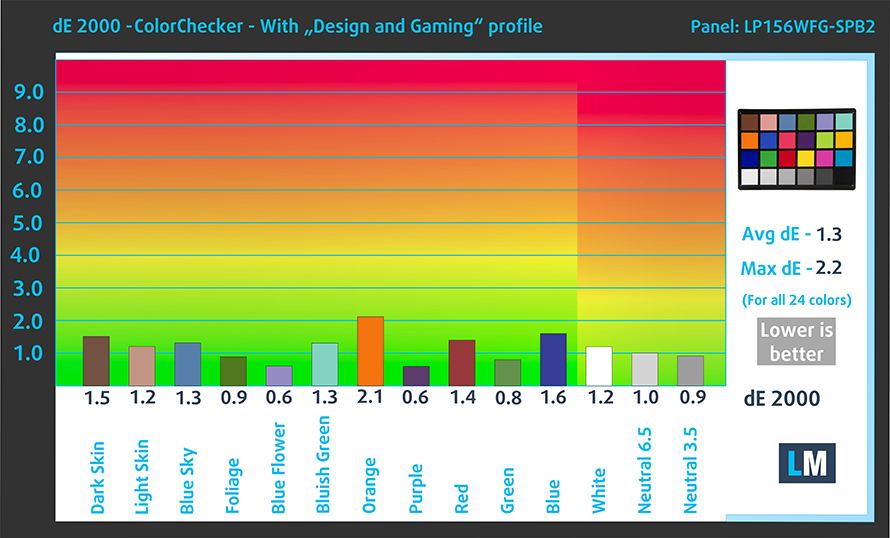
The next figure shows how well the display is able to reproduce really dark parts of an image, which is essential when watching movies or playing games in low ambient light.
The left side of the image represents the display with stock settings, while the right one is with the “Gaming and Web Design” profile activated. On the horizontal axis, you will find the grayscale and on the vertical axis – the luminance of the display. On the two graphs below you can easily check for yourself how your display handles the darkest nuances but keep in mind that this also depends on the settings of your current display, the calibration, the viewing angle, and the surrounding light conditions.

Response time (Gaming capabilities)
We test the reaction time of the pixels with the usual “black-to-white” and “white-to-black” method from 10% to 90% and vice versa.
We recorded Fall Time + Rise Time = 13 ms. The panel is fast!

PWM (Screen flickering)
Pulse-width modulation (PWM) is an easy way to control monitor brightness. When you lower the brightness, the light intensity of the backlight is not lowered, but instead turned off and on by the electronics with a frequency indistinguishable to the human eye. In these light impulses, the light/no-light time ratio varies, while brightness remains unchanged, which is harmful to your eyes. You can read more about that in our dedicated article on PWM.
As the screen found on the “cheaper” Legion Y530, the one inside Y730 doesn’t use PWM to adjust its screen brightness. This renders it safe and easy on the eyes for extended periods of use.

Blue light emissions
Installing our Health-Guard profile not only eliminates PWM but also reduces the harmful Blue Light emissions while keeping the colors of the screen perceptually accurate. If you’re not familiar with the Blue light, the TL;DR version is – emissions that negatively affect your eyes, skin and your whole body. You can find more information about that in our dedicated article on Blue Light.
Conclusion
The display of Lenovo Legion Y530 has an IPS panel with Full HD resolution, comfortable viewing angles, good contrast ratio, not bad max brightness, and it also lacks PWM. As a drawback, we can point the poor color gamut coverage.
Buy our profiles
Since our profiles are tailored for each individual display model, this article and its respective profile package are meant for Lenovo Legion Y730 configurations with 15.6″ FHD IPS LG LP156WFG-SPB2 (LGD05CF).
*Should you have problems with downloading the purchased file, try using a different browser to open the link you’ll receive via e-mail. If the download target is a .php file instead of an archive, change the file extension to .zip or contact us at [email protected].
Read more about the profiles HERE.
In addition to receiving efficient and health-friendly profiles, by buying LaptopMedia's products you also support the development of our labs, where we test devices in order to produce the most objective reviews possible.

Office Work
Office Work should be used mostly by users who spend most of the time looking at pieces of text, tables or just surfing. This profile aims to deliver better distinctness and clarity by keeping a flat gamma curve (2.20), native color temperature and perceptually accurate colors.

Design and Gaming
This profile is aimed at designers who work with colors professionally, and for games and movies as well. Design and Gaming takes display panels to their limits, making them as accurate as possible in the sRGB IEC61966-2-1 standard for Web and HDTV, at white point D65.

Health-Guard
Health-Guard eliminates the harmful Pulse-Width Modulation (PWM) and reduces the negative Blue Light which affects our eyes and body. Since it’s custom tailored for every panel, it manages to keep the colors perceptually accurate. Health-Guard simulates paper so the pressure on the eyes is greatly reduced.
Get all 3 profiles with 33% discount
Sound
Legion Y730 produces a good quality sound. It has clear low, mid and high frequencies.
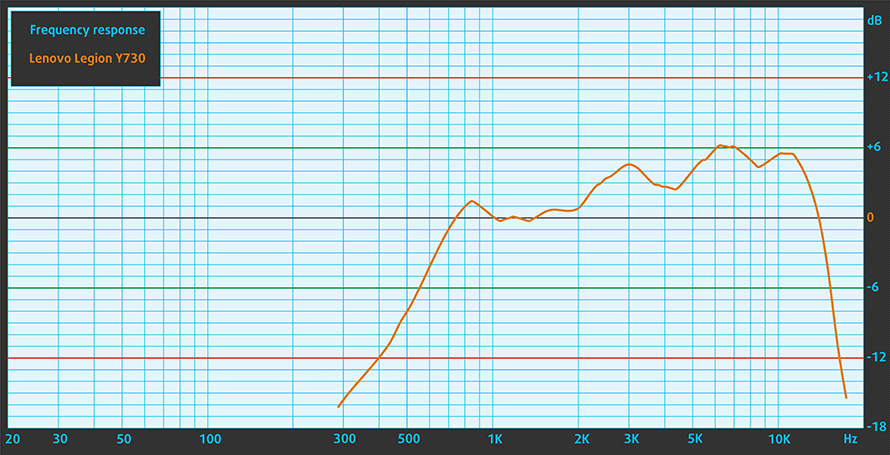
Drivers
All of the drivers and utilities for the Lenovo Legion Y730 can be found on Lenovo’s dedicated website: https://pcsupport.lenovo.com/bg/en/products/laptops-and-netbooks/legion-series/legion-y730-15ich/downloads
Storage performance
The sample we tested was equipped with a 128GB NVMe SSD with a model name Toshiba KBG30ZMT128G. It is definitely one of the budget NVMe SSDs, since we got only 1.14 GB/s of Read and mere 0.13 GB/s Write speeds. For comparison, right below the drive we tested is the one equipped on the Lenovo Legion Y530. However, keep in mind that it is highly unlikely for you to get the same NVMe SSD inside your Legion Y730.
| SSD model (120-256GB variants) | Max.Seq.Read (GB/s) | Max.Seq.Write (GB/s) | IOPS 4K Read | IOPS 4K Write | Latency Read (ms) | Latency Write (ms) |
| Toshiba KBG30ZMT128G 128GB (NVMe) | 1.14 | 0.13 | 7374 | 16434 | 0.090 | 0.255 |
| Intel SSD 760p / PEKKW256G8L (NVMe) | 2.35 | 1.03 | 13340 | 24671 | 0.047 | 0.048 |
| Toshiba THNSN5256GPU7 TO (NVMe) | 2.58 | 1.20 | 9521 | 27646 | 0.069 | 0.037 |
| Samsung SM951 (NVMe) | 2.24 | 1.29 | 11320 | 28450 | 0.057 | 0.034 |
| SK Hynix SC300 (NVMe) | 3.19 | 0.91 | 11000 | 26180 | 0.060 | 0.053 |
CrystalDiskMark – Max.Seq.Read/Write; AS SSD – IOPS 4K Read/Write, Latency Read/Write
Battery
Now, we conduct the battery tests with Windows Better performance setting turned on, screen brightness adjusted to 120 nits and all other programs turned off except for the one we are testing the notebook with. Even though the unit we examined wasn’t a retail one, the results we got were pretty adequate. Hence, you could expect similar results in the final version – 5 hours of web browsing, 4 hours and a half of video playback. If you are eager to play games away from the plug, you have to be quick, as the battery is going to drain in less than an hour and a half.
In order to simulate real-life conditions, we used our own script for automatic web browsing through over 70 websites.
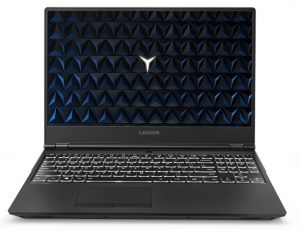
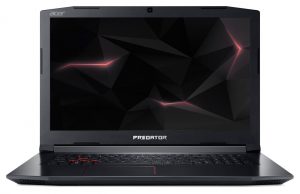
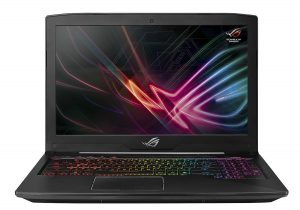
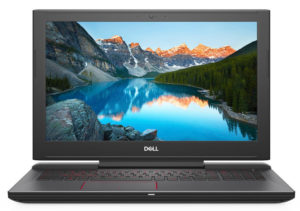
For every test like this, we use the same video in HD.




We use F1 2017’s built-in benchmark on loop in order to simulate real-life gaming.




CPU options
Legion Y730 is offered with a choice of the quad-core Intel Core i5-8300H, that has 8 MB of cache and is clocked at 2.30 GHz base frequency and reaches up to 4.00 GHz in Turbo mode. The other choice is a hexacore Intel Core i7-8750H with 9 MB of cache, 2.20 GHz base frequency and 4.1 in Turbo.
Results are from the Cinebench 20 CPU test (the higher the score, the better)
Results are from our Photoshop benchmark test (the lower the score, the better)
Results are from the Fritz chess benchmark (the higher the score, the better)
GPU options
Interestingly, Legion Y730 is offered only with NVIDIA GeForce GTX 1050 Ti.
Results are from the 3DMark: Fire Strike (Graphics) benchmark (higher the score, the better)
Results are from the Unigine Superposition benchmark (higher the score, the better)
Gaming tests
Lenovo Legion Y730 performs on par with other GTX 1050 Ti-equipped notebooks.

| Grand Theft Auto V (GTA 5) | Full HD, Normal (Check settings) | Full HD, High (Check settings) | Full HD, Very High (Check settings) |
|---|---|---|---|
| Average | 123 fps | 75 fps | 41 fps |

| Far Cry Primal | Full HD, Normal (Check settings) | Full HD, High (Check settings) | Full HD, Very High (Check settings) |
|---|---|---|---|
| Average | 57 fps | 51 fps | 43 fps |

| Rise of the Tomb Raider (2016) | Full HD, Lowest (Check settings) | Full HD, Medium (Check settings) | Full HD, Very High (Check settings) |
|---|---|---|---|
| Average | 89 fps | 61 fps | 30 fps |

| Tom Clancy’s Ghost Recon Wildlands | Full HD, Medium (Check settings) | Full HD, High (Check settings) | Full HD, Very High (Check settings) |
|---|---|---|---|
| Average | 44 fps | 41 fps | 36 fps |
Temperatures and comfort
Max CPU load
In this test we use 100% on the CPU cores, monitoring their frequencies and chip temperature. The first column shows a computer’s reaction to a short load (2-10 seconds), the second column simulates a serious task (between 15 and 30 seconds), and the third column is a good indicator of how good the laptop is for long loads such as video rendering.

Average core temperature (base frequency + X); CPU temp.
| Intel Core i7-8750H (45W TDP) | 0:02 – 0:10 sec | 0:15 – 0:30 sec | 10:00 – 15:00 min |
|---|---|---|---|
| Lenovo Legion Y730 [Sample] | 3.43 GHz (B+56%) @ 91°C | 3.23 GHz (B+47%) @ 94°C | 2.69 GHz (B+22%) @ 79°C |
| Lenovo Legion Y530 [Sample] | 3.24 GHz (B+47%) @ 94°C | 3.20 GHz (B+45%) @ 94°C | 2.97 GHz (B+35%) @ 94°C |
| Acer Nitro 5 | 2.89 GHz (B+31%) @ 72°C | 2.71 GHz (B+23%) @ 78°C | 2.52 GHz (B+15%) @ 74°C |
| ASUS TUF FX504 | 2.59 GHz (B+18%) @ 71°C | 2.64 GHz (B+20%) @ 82°C | 2.46 GHz (B+12%) @ 74°C |
| Alienware 15 R4 | 2.86 GHz (B+30%) @ 93°C | 2.32 GHz (B+5%) @ 74°C | 2.31 GHz (B+5%) @ 66°C |
| ASUS ROG GL503GE | 2.89 GHz (B+31%) @ 66°C | 2.89 GHz (B+31%) @ 69°C | 2.53 GHz (B+15%) @ 71°C |
Here you can see a comparison of some of the most popular devices, using Intel Core i7-8750H. We can still see a performance-oriented thermal configuration. Moreover, a little improvement over the Legion Y530 in the first and the second segment, while in the longest run we saw a drop to 2.69 GHz. Although it is lower than the Legion Y530, we prefer it to be that way, since the temperature stays a little under 80C, which can result in hardware preservation in the future.
Real gameplay
| GPU frequency/ Core temp (after 2 min) | GPU frequency/ Core temp (after 30 min) | |
|---|---|---|
| Lenovo Legion Y730 [Sample] | 1734 MHz @ 66°C | 1721 MHz @ 71°C |
| Lenovo Legion Y530 [Sample] | 1696 MHz @ 72°C | 1683 MHz @ 75°C |
| ASUS ROG GL503GE | 1696 MHz @ 74°C | 1671 MHz @ 83°C |
Despite the lower results in the Gaming tests, we see one of the highest clock speeds of a GeForce GTX 1050 Ti. This result is enormous, keeping in mind that on paper, the maximum Boost clock of this GPU is good 100 MHz less than what the Legion Y730 was able to achieve. Moreover, it did so with temperatures never exceeding 71C.
Gaming comfort
After half an hour of gaming, the hottest spot on the keyboard we measured was 42C and is located right in the middle of the device. This is a pretty reasonable surface temperature on a thin gaming laptop. Also, you can clearly see the fan locations on the IR images below.


Verdict
 If you are here because of your love for Lenovo Legion Y530 and you wanted to see how one of the best budget gaming notebooks is taken to another level, you might just get a little disappointed. Well, don’t get us wrong, Legion Y730 is still an improvement over the cheaper version. Nonetheless, it is not near the improvement of the Legion Y720 over the Y520 from last year.
If you are here because of your love for Lenovo Legion Y530 and you wanted to see how one of the best budget gaming notebooks is taken to another level, you might just get a little disappointed. Well, don’t get us wrong, Legion Y730 is still an improvement over the cheaper version. Nonetheless, it is not near the improvement of the Legion Y720 over the Y520 from last year.
However, just take a look at that magnificent screen. Apart from working at a 144 Hz refresh rate, it is super color accurate with a deltaE of just 2.7 which drops down to 1.3 with the help of our Gaming and Web design profile. Clearly an impressive result. Plus, there is the 96% sRGB coverage and lack of harmful PWM in brightness adjustment. The only possible downside of this screen is the 300 nits maximum brightness. We are definitely nit-picking right now but no lie it is lower than what you can find in the 144 Hz screen on the HP Omen 15 (2018) or the one in ASUS ROG GL504.
When it comes to battery, we are happy to announce that Legion Y730 has one… It is not exceptional by any means, neither is it special. It is just like an old Ford Escort – it gets you from point A to point B and you should be happy about it. If you are the show off type and you want to show your Legion Y730 and its nice looking display to people, you have no more than 5 hours to do so before it turns into an expensive bathroom tile.
While it is clearly not the best performer, Lenovo Legion Y730 is one hell of a laptop and it clearly deserves our Editor’s Choice award. However, if you wish to get more frame rates we would recommend something like Acer’s Helios 300, which is, in fact, cheaper, but is equipped with a more powerful – GTX 1060 GPU.
Pros
- Lightweight, compact with thin bezels
- Comfortable port distribution
- Comfortable keyboard with RGB option
- IPS display with high contrast and good viewing angles (+ 144 Hz display panel option)
- Lack of PWM
- Good build quality
- Customizable keys
- Good cooling solution
Cons
- Relatively high price for the given hardware
You can check the prices and configurations in our Specs System: https://laptopmedia.com/series/lenovo-legion-y730-15/
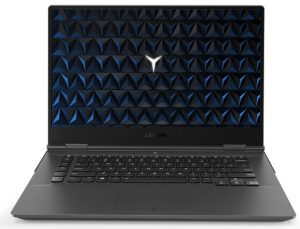








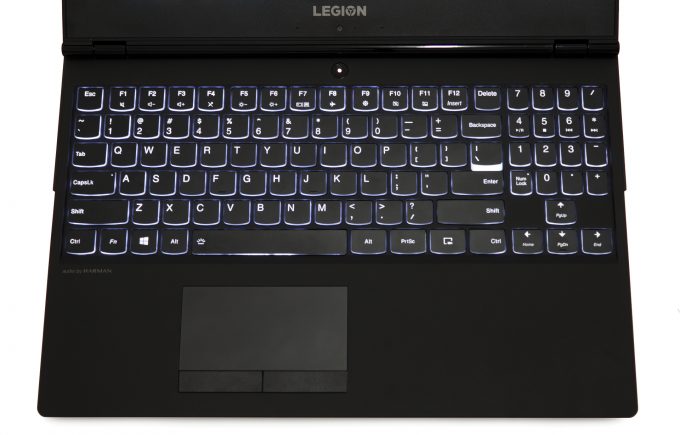




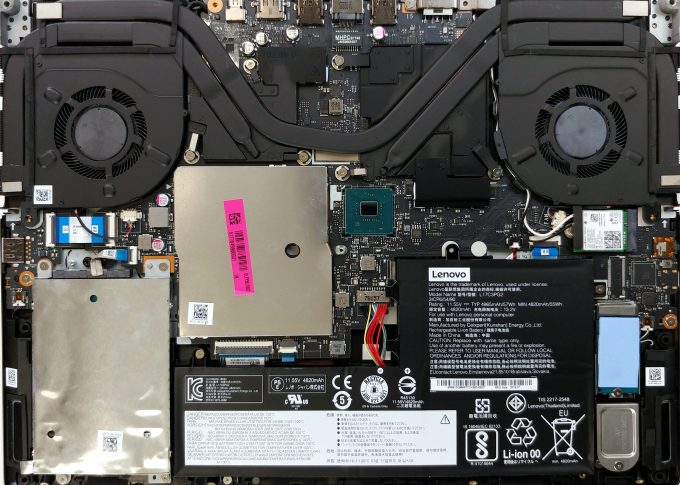




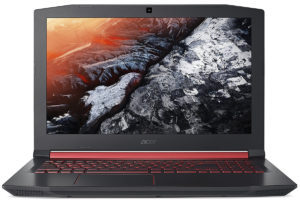








Hello. I need the help with this notebook Lenovo Legion Y730-17ich. I need the schematic for this motherboard LA-G131P. Please, who can help me?